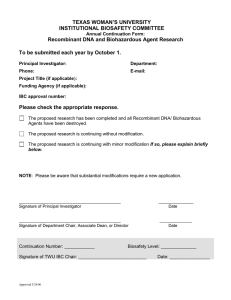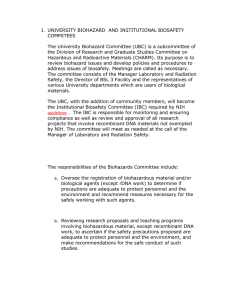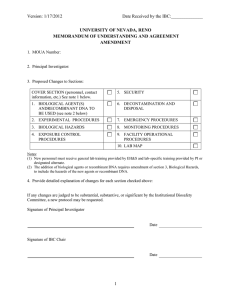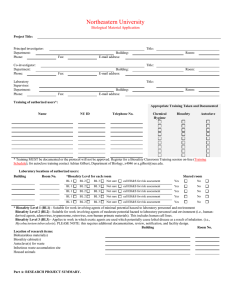Northeastern University Biological Material Application
advertisement
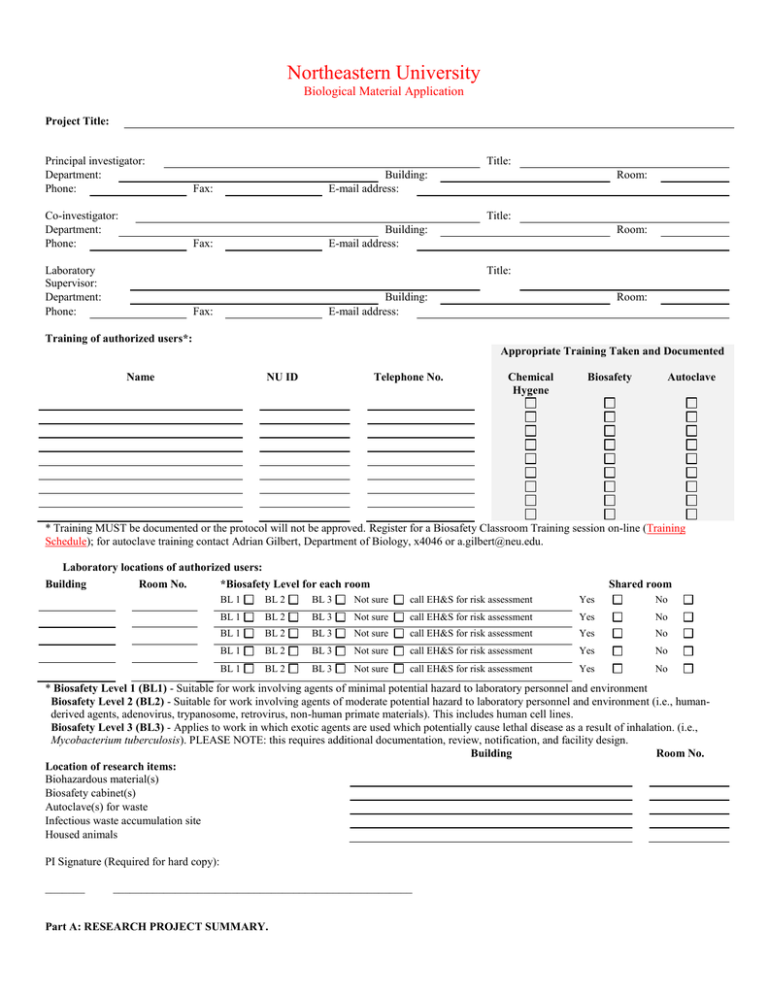
Northeastern University Biological Material Application Project Title: Principal investigator: Department: Phone: Co-investigator: Department: Phone: Title: Fax: Building: E-mail address: Fax: Building: E-mail address: Room: Title: Laboratory Supervisor: Department: Phone: Room: Title: Building: E-mail address: Fax: Room: Training of authorized users*: Appropriate Training Taken and Documented Name NU ID Telephone No. Chemical Hygene Biosafety Autoclave * Training MUST be documented or the protocol will not be approved. Register for a Biosafety Classroom Training session on-line (Training Schedule); for autoclave training contact Adrian Gilbert, Department of Biology, x4046 or a.gilbert@neu.edu. Laboratory locations of authorized users: Building Room No. *Biosafety Level for each room Shared room BL 1 BL 2 BL 3 Not sure call EH&S for risk assessment Yes No BL 1 BL 2 BL 3 Not sure call EH&S for risk assessment Yes No BL 1 BL 2 BL 3 Not sure call EH&S for risk assessment Yes No BL 1 BL 2 BL 3 Not sure call EH&S for risk assessment Yes No BL 1 BL 2 BL 3 Not sure call EH&S for risk assessment Yes No * Biosafety Level 1 (BL1) - Suitable for work involving agents of minimal potential hazard to laboratory personnel and environment Biosafety Level 2 (BL2) - Suitable for work involving agents of moderate potential hazard to laboratory personnel and environment (i.e., humanderived agents, adenovirus, trypanosome, retrovirus, non-human primate materials). This includes human cell lines. Biosafety Level 3 (BL3) - Applies to work in which exotic agents are used which potentially cause lethal disease as a result of inhalation. (i.e., Mycobacterium tuberculosis). PLEASE NOTE: this requires additional documentation, review, notification, and facility design. Building Room No. Location of research items: Biohazardous material(s) Biosafety cabinet(s) Autoclave(s) for waste Infectious waste accumulation site Housed animals PI Signature (Required for hard copy): _______ _____________________________________________________ Part A: RESEARCH PROJECT SUMMARY. Per the NIH Guidelines, two members of the Institutional Biosafety Committee (IBC) are community representatives. In order for these members of the committee to understand the proposed research, use lay terms to provide a brief description of the overall objectives and goals of this research. Briefly explain how the agents will be used. Do not use field-specific terms and phrases. The grey field will expand as text is entered. Please provide the purpose and description for your experiment(s)/project in lay terms. Part B: EXPERIMENTAL DETAILS Provide a concise description your laboratory procedures involving biohazardous agents, including all research involving recombinant and synthetic DNA/RNA that you will be performing and include: Enough information so that the techniques of the experiments with the biohazardous materials are clear. Indicate the culture volumes, maximum concentrations and other agent specific information. Identify at what stage the agent is inactivated. Provide a risk assessment for the materials and procedures (e.g. risk group of agents, hazards of procedures, etc.) Outline the controls that are in place to protect against exposure (e.g. personal protective equipment, etc.) Be concise and use non-technical terms as reasonably possible, however scientific information and terminology may be used to explain experimental procedures. The grey field will expand as text is entered. Please be as concise as possible describing experimental details. Part C: RECOMBINANT DNA Host, vector and gene information N/A Name Strain # or Name Source* –Commercial or Laboratory (Name & Location) Host(s): Vector, plasmids(s): Inserted DNA/Gene(s) to be cloned: Is the source of these agents a non-commercial laboratory? No Yes - You must contact the Office of Research Administration and Finance at 617.373.5600 to inquire about a Material Transfer Agreement (MTA). A copy of the fully executed MTA is required for approval by the IBC. PI Signature (Required for final hard copy): ____________________________________________________________ Risk group 1 (RG 1) agents not associated with disease in healthy adults. Risk group 2 (RG 2) agents associated with human disease but for which preventative or therapeutic interventions are often available. Risk group 3 (RG 3) agents associated with serious or lethal human disease for which preventive or therapeutic interventions may not be available Please indicate "Yes" or "No" for each of the statements below: Yes No I am inserting foreign DNA or RNA into a vector or organism to clone or express it. The DNA or RNA to be cloned: Yes No Is from a risk group 3 agent. Yes No Represents more than two-thirds of the genome of a risk group 1 or 2 agent. Yes No Encodes a known oncogene. Yes No Encodes molecules known to be toxic to vertebrates at concentrations of less than 1 mg/ml (body weight in kg). The vector I am using for introducing a foreign DNA or RNA into the host: Yes No Is from a Risk group 3 agent. Yes No Is a risk group 1 or 2 virus that infects eukaryotic cells and contains more than two-thirds of the viral genome? Yes No The host into which I am introducing foreign DNA or RNA is a cell or organism other than E. coli K-12 or its derivatives, Saccharomyces cerevisiae, S. uvarum, Bacillus subtilis or B. licheniformis. Part D. Human and non-human primate cell lines, tissues, blood and other biological materials. Name/Description - Cell Lines, Tissues, Blood, and Other Biological Materials Strain # N/A Source* –Commercial or Laboratory (Name & Location) Is the source of these agents a non-commercial laboratory? No Yes - You must contact the Office of Research Administration and Finance at 617.373.5600 to inquire about a Material Transfer Agreement (MTA). A copy of the fully executed MTA is required for approval by the IBC. Part E: INFECTIOUS AGENTS and TOXINS Infectious or potentially infectious agent(s) and Strain # or Name toxin(s): N/A Concentration of Toxin * Source** –Commercial or Laboratory (Name & Location) Is the source of these agents a non-commercial laboratory? No Yes - You must contact the Office of Research Administration and Finance at 617.373.5600 to inquire about a Material Transfer Agreement (MTA). A copy of the fully executed MTA is required for approval by the IBC. Will the experiment(s) result in acquisition of new characteristics such as enhanced virulence, infectivity, drug resistance, or change in host range by the infectious agent? Yes, please explain: No PI Signature (Required for final hard copy): ____________________________________________________________ IBC Application Form : rev 07/11/2016 CONFIDENTIAL Page 3 of 8 NOTE: Please attach additional tables if you have more than two biological agents. Potential Hazard of Biological Agent(s) 1: 2: Agents Host Agents Route(s) of Transmission to animals and humans (droplets, fecal-oral, blood, insect bites, aerosol, other) Virulence- Quantity or concentration of minimum infectious dosage if known Pathogenicity and Health Hazards- Provide information on the severity of disease; include signs and symptoms of exposure and include other health hazards that are associated with the agent Natural vector if known Immunization or vaccinations if known. Is it susceptible to antibiotic; known resistance to any antibiotics At what stage of the experiment is the infectious material inactivated? Do your SOP's involve viable or non-viable organisms References for hazards of Biological Agents (Consider CDC website as possible source). Part F: SELECT AGENTS/TOXINS (Due to the nature of these agents and toxins, Federal Government approval is required). SELECT AGENTS/TOXINS The United States Department of Health and Human Services (HHS) and the United States Department of Agriculture (USDA) have identified bacteria, viruses, toxins, protozoa, and fungi that pose a potential threat to public health or welfare. These organisms are considered Select Agents and High Consequence Livestock Pathogens and Toxins. See List at EH&S Website USDA and HHS Select Agents and Toxins List USING SELECT AGENTS and TOXINS N/A Please select the correct statement. I am not using any of the select agents or toxins listed on EH&S website I am using at least one of the select agents or toxins listed on EH&S website. I am using an attenuated strain excluded by HHS and/or USDA (next to agent name state “attenuated strain”) Signature of Principal Investigator: List agents or toxins being used: Agent/Toxin Strain # or Name Concentration of Toxin Source* –Commercial or Laboratory (Name & Location) Is the source of these agents a non-commercial laboratory? No Yes - You must contact the Office of Research Administration and Finance at 617.373.5600 to inquire about a Material Transfer Agreement (MTA). A copy of the fully executed MTA is required for approval by the IBC. PI Signature (Required for final hard copy): ____________________________________________________________ IBC Application Form : rev 07/11/2016 CONFIDENTIAL Page 4 of 8 Part G: TRANSPORTATION OF BIOLOGICAL MATERIALS Please provide written procedure on how the biological material will be transported to Northeastern University. We are required to meet all State, U.S. Department of Transportation (DOT) and United Nations International Civil Aviation Organization (ICAO), and International Air Transport Association (IATA) regulation. Material obtained from a non-commercial source including Boston or Cambridge is required to utilize the services of a courier service: Do you plan on shipping any form of the material from Northeastern University yes no If yes, please review the Hazardous Materials Declaration Form and list the biological category the material falls under: The following services are available for transportation to and from Northeastern University. The PI/courier service provider must insure that packaging follows the DOT guidelines. City Express Courier Service World Courier Ground Boston, MA Sharon, MA 617-350-4000 781-793-0800 or 1-800-521-2211 www.cityexp.com http://www.wcground.com/ If a package has a biological concern, you may use the following courier service that will classify, package and ship the material: Biocair Boston, MA 617-263-0544 www.biocair.com PART H. STANDARD OPERATING PROCEDURES (SOP) AND SAFETY PRACTICES (SP). Please select the experimental procedure(s) involved with your protocol from the list provided. Once selected, edit the protocol to reflect your laboratory’s specific procedures. Save the revised protocol onto your computer and submit it electronically with the completed application. If your SOP(s) is/are not included in the list please write up the procedure in a Word file send it as an attachment with your completed application. Your SOP will be added to the list for future reference. Addition of new Standard Operating Procedures/Protocols Cell Freezing, SOP Counting and Passaging Procedure, SOP Incubator Cleaning, SOP Preparing Karnovskys Fixative, SOP Mixing Vitrogen (PureCol), SOP Preparing Nutrient Agar Plates, SOP Surface Functionalization for Collagen, SOP Thawing Frozen Cells, SOP Required SOP for all protocols. Edit procedure and save to reflect your particular laboratory procedures. SOP Disinfecting and Waste PI Signature (Required for hard copy): ____________________________________________________________ IBC Application Form : rev 07/11/2016 CONFIDENTIAL Page 5 of 8 Decontamination of Work Areas and Equipment All work areas and equipment will be decontaminated with a liquid chemical disinfectant The disinfectant will be applied liberally. If bleach is used, the solution will be made fresh daily basis using 1 part bleach in 10 parts water. The solution will be labeled as to contents and date of preparation List disinfectant(s), concentration(s) and contact time(s) that will be used (i.e. bleach, Wescodyne, 70% ethanol or other): On work surfaces: List all equipment to be decontaminated (Note: Any equipment that comes into contact with biological material): PI Signature Required (in print for electronic version, by hand for hard copy): Disinfecting and Waste SOP IBC Application Form : rev 07/11/2016 CONFIDENTIAL Page 6 of 8 Decontamination of Work Areas and Equipment All work areas and equipment will be decontaminated with a liquid chemical disinfectant (insert name of disinfectant, concentration and contact time). The disinfectant will be applied liberally. If bleach is used, the solution will be made fresh on a daily basis using 1 part bleach in 9 parts water. The solution will be labeled as to contents and date of preparation. Equipment to be decontaminated includes bench tops, biosafety cabinets, all benchtop equipment, and incubators. Waste Management Per Massachusetts regulations: All sharps will be placed in a leak-proof, labeled sharps container regardless of whether they are contaminated with biohazardous material. Care must be taken to not overfill the container. Close the container when approximately 2/3 full and use a new container. Serological pipets and micropipette tips will be treated as a sharp and will be disposed of in either a pipet keeper or Bio-bin. The PI’s name and lab number will be written on the side of the container and will be dropped off at the closest sharps collection location (insert room number and building). All biohazardous liquids will be treated with sodium hypochlorite (bleach). One part bleach will be added to 9 parts of liquid. The solution will be allowed to sit for at least 30 minutes prior to sink disposal. All solid non-sharp biohazardous materials will be placed in red, labeled containers lined with clear biohazard bags that do not have a biohazard label. Containers will be closed when not in use. When approximately 2/3 full, the container will be transported to the autoclave room (insert building and room number of the autoclave you use) and bags will be removed from the container and autoclaved (insert temperature and time). Bags will be kept in a labeled container at all times until rendered non-infectious. All biohazardous solid waste will remain in a red container labeled with the biohazard symbol until it is rendered non-infectious. When cool, autoclaved bags will be bagged in a black bag. All personnel will attend autoclave training and take the online autoclave training through the EH&S web site. Principal Investigator’s Certification: IBC Application Form : rev 07/11/2016 CONFIDENTIAL Page 7 of 8 By signing below, I certify that I have read the following statements and agree that all listed participated and I will abide by those statements as well as all NU policies and procedures governing the use of recombinant DNA, infectious agents and other biological materials as outline in this application and in the NU Biosafety Manual. In addition, I will: Ensure that listed personnel have or will receive appropriate training in safe laboratory practices and procedures for this protocol before any work begins on this project and will receive required refresher training thereafter. Also, all listed personnel who have potential occupational exposure to blood borne pathogens will file a Hepatitis B declaration form with EH&S (x2769) and be trained annually; Follow the health surveillance practices as approved for this protocol and inform those working on the protocol about appropriate emergency assistance information for their location(s); Inform EH&S (x2769) of any research-related accident or illness as soon as possible after its occurrence. All research related accidents and illnesses should go through the Baptist Hospital. A referral is needed from Risk Services (x5396); Submit in writing a request for approval from the IBC (x2769) of any significant modifications to the study, facilities or procedures; Adhere to NU’s biosafety guidelines referred to in this application as well as comply with the requirements of the Biosafety Manual. Abide by all Federal, State and Boston Regulations governing research including the NIH guidelines on recombinant DNA and OSHA on Blood Borne Pathogens; and Report potentially toxic exposure to recombinant DNA materials, any incident releasing recombinant DNA materials into the environment, any problem with physical or biological containment and new information related to my research on the safety and biological hazard of the recombinant DNA molecules being studied to the NU Biosafety Officer, NIH and the City of Boston. Signatures: Principal investigator: Date: Shared space principal investigator: Date: IBC chair: Date: \\\ Application status: This project involves: For EH&S use only Reg No.: First review date: Action: Initial submittal Biohazardous agents Second review date: Action: Renew Reg No. Recombinant DNA Third review date: Action: Retire Reg No. USDA-regulated materials Approval date: Expiration date: For IBC/BSO use only IBC Application Form : rev 07/11/2016 IBC-level approval CONFIDENTIAL BSO-level approval Page 8 of 8
